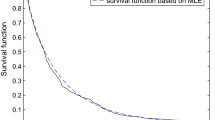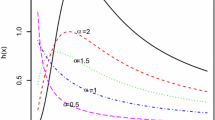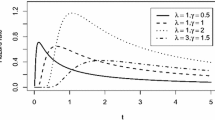Abstract
Let a progressively type-II (PT-II) censored sample of size m is available. Under this set-up, we consider the problem of estimating unknown model parameters and two reliability characteristics of the log-logistic distribution. Maximum likelihood estimates (MLEs) are obtained. We use expectation–maximization (EM) algorithm. The observed Fisher information matrix is computed. We propose Bayes estimates with respect to various loss functions. In this purpose, we adopt Lindley’s approximation and importance sampling methods. Asymptotic and bootstrap confidence intervals are derived. Asymptotic intervals are obtained using two approaches: normal approximation to MLEs and log-transformed MLEs. The bootstrap intervals are computed using boot-t and boot-p algorithms. Further, highest posterior density (HPD) credible intervals are constructed. Two sets of practical data are analyzed for the illustration purpose. Finally, detailed simulation study is carried out to observe the performance of the proposed methods.






Similar content being viewed by others
References
Abbas K, Tang Y (2016) Objective Bayesian analysis for log-logistic distribution. Commun Stat Simul Comput 45(8):2782–2791
Aggarwala R, Balakrishnan N (1998) Some properties of progressive censored order statistics from arbitrary and uniform distributions with applications to inference and simulation. J Stat Plan Inference 70(1):35–49
Ahmad M, Sinclair C, Werritty A (1988) Log-logistic flood frequency analysis. J Hydrol 98(3–4):205–224
Ashkar F, Mahdi S (2003) Comparison of two fitting methods for the log-logistic distribution. Water Resour Res 39(8):12–17
Balakrishnan N (2007) Progressive censoring methodology: an appraisal. Test 16(2):211
Balakrishnan N, Aggarwala R (2000) Progressive censoring: theory, methods, and applications. Springer, Berlin
Balakrishnan N, Cramer E (2014) The art of progressive censoring. Springer, Berlin
Balakrishnan N, Sandhu R (1995) A simple simulational algorithm for generating progressive type-II censored samples. Am Stat 49(2):229–230
Barot D, Patel M (2017) Posterior analysis of the compound Rayleigh distribution under balanced loss functions for censored data. Commun Stat Theory Methods 46(3):1317–1336
Basak I, Balakrishnan N (2017) Prediction of censored exponential lifetimes in a simple step-stress model under progressive Type II censoring. Comput Stat 32(4):1665–1687
Best DJ, Rayner JC, Thas O (2010) Easily applied tests of fit for the Rayleigh distribution. Sankhya B 72(2):254–263
Bjerkedal T (1960) Acquisition of resistance in guinea pies infected with different doses of virulent tubercle bacilli. Am J Hyg 72(1):130–148
Chen MH, Shao QM (1999) Monte carlo estimation of Bayesian credible and HPD intervals. J Comput Graph Stat 8(1):69–92
Dempster AP, Laird NM, Rubin DB (1977) Maximum likelihood from incomplete data via the EM algorithm. J R Stat Soc Ser B 39(1):1–38
Dey S, Dey T, Luckett DJ (2016) Statistical inference for the generalized inverted exponential distribution based on upper record values. Math Comput Simul 120:64–78
Dey S, Singh S, Tripathi YM, Asgharzadeh A (2016) Estimation and prediction for a progressively censored generalized inverted exponential distribution. Stat Methodol 32:185–202
Efron B, Tibshirani R (1986) Bootstrap methods for standard errors, confidence intervals, and other measures of statistical accuracy. Stat Sci 1(1):54–75
Fisk P (1961) Estimation of location and scale parameters in a truncated grouped sech square distribution. J Am Stat Assoc 56(295):692–702
Greene WH (2000) Econometric analysis, 4th edn. Prentice-Hall, New York
Hall P (1988) Theoretical comparison of bootstrap confidence intervals. Ann Stat 16(3):927–953
He X, Chen W, Qian W (2018) Maximum likelihood estimators of the parameters of the log-logistic distribution. Stat Pap 1–18
Kharazmi O, Mahdavi A, Fathizadeh M (2015) Generalized weighted exponential distribution. Commun Stat Simul Comput 44(6):1557–1569
Khorram E, Meshkani Farahani ZS (2014) Statistical inference of weighted exponential lifetimes under progressive Type II censoring scheme. Qual Technol Quant Manag 11(4):433–451
Kumar K (2018) Classical and Bayesian estimation in log-logistic distribution under random censoring. Int J Syst Assur Eng Manag 9(2):440–451
Kus C, Kaya MF (2006) Estimation of parameters of the loglogistic distribution based on progressive censoring using the EM algorithm. Hacet J Math Stat 35(2):203–211
Langlands AO, Pocock SJ, Kerr GR, Gore SM (1979) Long-term survival of patients with breast cancer: a study of the curability of the disease. Br Med J 2(6200):1247–1251
Lindley DV (1980) Approximate Bayesian methods. Trabajos de Estadistica Y de Investigacion Operativa 31(1):223–245
Louis TA (1982) Finding the observed information matrix when using the EM algorithm. J R Stat Soc Ser B (Methodol) 44(2):226–233
Mahmoudi E (2011) The beta generalized pareto distribution with application to lifetime data. Math Comput Simul 81(11):2414–2430
Maiti K, Kayal S (2019a) Estimation for the generalized Fréchet distribution under progressive censoring scheme. Int J Syst Assur Eng Manag 10(5):1276–1301
Maiti K, Kayal S (2019b) Estimation of parameters and reliability characteristics for a generalized Rayleigh distribution under progressive type-II censored sample. Commun Stat Simul Comput. https://doi.org/10.1080/03610918.2019.1630431
Mäkeläinen T, Schmidt K, Styan GP (1981) On the existence and uniqueness of the maximum likelihood estimate of a vector-valued parameter in fixed-size samples. Ann Stat 9(4):758–767
Meeker WQ, Escobar LA (1998) Statistical methods for reliability data. Wiey, New York
Mielke JR, PAUL W, Johnson ES (1973) Three-parameter kappa distribution maximum likelihood estimates and likelihood ratio tests. Mon Weather Rev 101(9):701–707
Mudholkar GS, Srivastava DK, Kollia GD (1996) A generalization of the weibull distribution with application to the analysis of survival data. J Am Stat Assoc 91(436):1575–1583
Ng H, Chan P, Balakrishnan N (2002) Estimation of parameters from progressively censored data using EM algorithm. Comput Stat Data Anal 39(4):371–386
Olson DL, Shi Y, Shi Y (2007) Introduction to business data mining, vol 10. McGraw-Hill/Irwin Englewood Cliffs, New York
Shi Y (2014) Big data: history, current status, and challenges going forward. Bridge 44(4):6–11
Shi Y, Tian Y, Kou G, Peng Y, Li J (2011) Optimization based data mining: theory and applications. Springer, Berlin
Shoukri M, Mian I, Tracy D (1988) Sampling properties of estimators of the log-logistic distribution with application to canadian precipitation data. Can J Stat 16(3):223–236
Singh S, Tripathi YM, Wu S-J (2015) On estimating parameters of a progressively censored lognormal distribution. J Stat Comput Simul 85(6):1071–1089
Singh S, Tripathi YM, Wu S-J (2018) Bayesian analysis for lognormal distribution under progressive type-II censoring. Hacet J Math Stat 48:1488–1504
Tierney L, Kadane JB (1986) Accurate approximations for posterior moments and marginal densities. J Am Stat Assoc 81(393):82–86
Valiollahi R, Raqab MZ, Asgharzadeh A, Alqallaf F (2018) Estimation and prediction for power Lindley distribution under progressively type II right censored samples. Math Comput Simul 149:32–47
Zhou YY, Mi J, Guo S (2007) Estimation of parameters in logistic and log-logistic distribution with grouped data. Lifetime Data Anal 13(3):421–429
Acknowledgements
One of the authors Kousik Maiti thanks the Ministry of Human Resource Development (M.H.R.D.), Government of India for the financial assistantship received to carry out this research work. The authors sincerely wish to thank the Editor in Chief, the anonymous reviewer for the suggestions which have considerably improved the content and the presentation of the paper.
Author information
Authors and Affiliations
Corresponding author
Additional information
Publisher's Note
Springer Nature remains neutral with regard to jurisdictional claims in published maps and institutional affiliations.
Appendix A
Appendix A
For the present problem, we have \((\eta _1,\eta _2)=(\alpha ,\beta )\). Denote \(\varpi (t_i; \alpha , \beta )=\frac{( \beta ^{\alpha } \ln \beta + t_i^{\alpha } \ln t_i)}{\beta ^{\alpha }+t_i^{\alpha }}\) and \(\varsigma (t_i; \alpha , \beta )=\frac{\alpha \beta ^{\alpha }}{\beta ^{\alpha }+t_i^{\alpha }}\). We obtain the following expressions, which are required to compute the desired Bayes estimates.
The following derivatives are useful for the computation of the Bayes estimates of r(t) and h(t) as discussed in Sect. 4.1.2. Under the LINEX loss function, \(\vartheta (\alpha ,\beta )=\exp \{-dr(t)\}\). Denote \(\iota (t; \alpha , \beta )=\frac{d \beta ^{\alpha } t^{\alpha } \exp \{-d r(t)\}}{\left( \beta ^{\alpha }+t^{\alpha }\right) ^2}\). Thus,
When the loss function is taken to be the entropy loss function, then \(\vartheta (\alpha ,\beta )=r(t)^{-c}\). Denote \(\Omega (t; \alpha , \beta )=t^\alpha r(t)^{-c}\). We compute the following derivatives:
Rights and permissions
About this article
Cite this article
Maiti, K., Kayal, S. Estimating Reliability Characteristics of the Log-Logistic Distribution Under Progressive Censoring with Two Applications. Ann. Data. Sci. 10, 89–128 (2023). https://doi.org/10.1007/s40745-020-00292-y
Received:
Revised:
Accepted:
Published:
Issue Date:
DOI: https://doi.org/10.1007/s40745-020-00292-y
Keywords
- EM algorithm
- Observed Fisher information matrix
- Bayes estimates
- Lindley’s method
- Importance sampling method
- Bootstrap interval
- HPD credible interval




